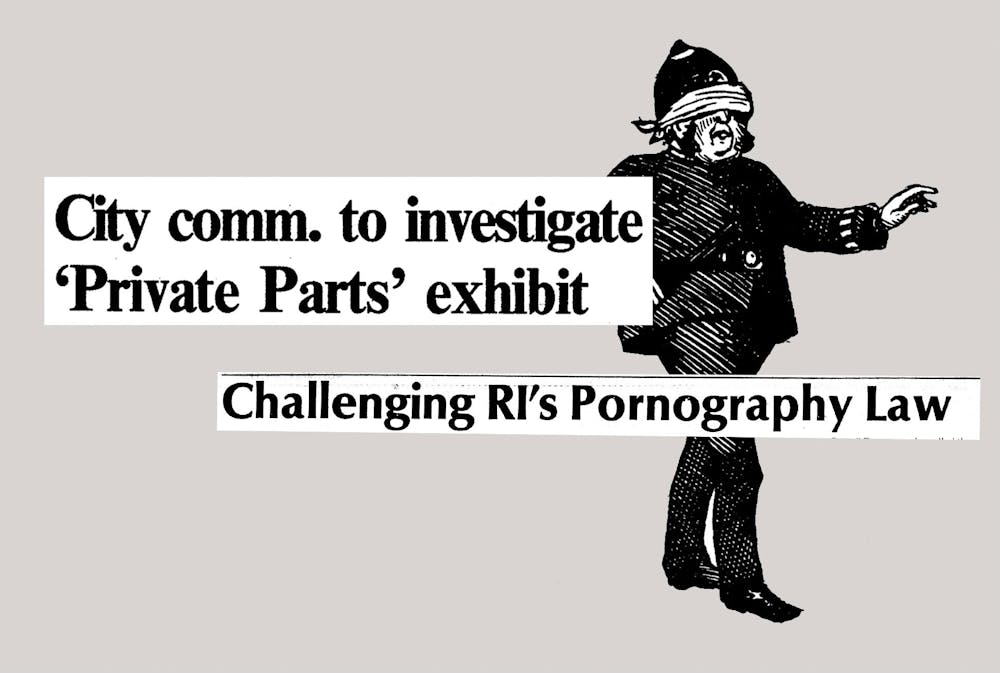On May 15, 1978, an exhibition titled “Private Parts” was set to debut at 128 Main St., organized by a group of Rhode Island School Design students. But the night before the opening, a Providence Police officer came to inspect the gallery. Though the officer didn’t personally take offense with the content of the exhibition, he informed the exhibitors that the police would raid the gallery on its opening day to enforce Rhode Island’s anti-obscenity laws.
Leading up to the release, advertisements appeared in the RISD Press, a weekly student newspaper, to promote the event. One such advertisement read, “ANY SIZE ANY MEDIUM ANY THING ANYONE ANY PRIVATE ANY PART.” The collective that produced this exhibition was not granted any gallery space on the RISD campus, so it had to seek other options for the show to go on.
The exhibition itself was intended to satirize pornography, but Providence Police took it as something more serious.
Unbeknownst to the artists and the exhibitors, The Providence Journal ran a piece that talked about the potential illegality of the show. Come opening day, the gallery was packed with people coming from all walks of life to see what all the fuss was about — before officers stormed in, peeling art off of the walls, explained Laurie McDonald, a member of the Electron Movers. The Electron Movers was the video arts collective composed of former RISD students that owned the gallery where the exhibition took place.
The medium of the exhibition was predominantly photography but also included paintings and drawings as well as a polaroid photo booth for visitors to operate. Much of the artwork — 40 pieces in total — was confiscated by the police and allegedly destroyed, so most of the works only remain in the memory of those in attendance.
One piece that stood out to McDonald was an image of “a rabbit humping a chicken,” which the chief of police personally removed from the walls of the gallery, she told The Herald. McDonald was unable to reference any works from the show that were overtly pornographic because she believes that that type of content wasn’t really present at the show.
McDonald was present during the raid and captured the siege on camera as it occurred. The original intention of the Electron Movers was not to make any sort of political statement by exhibiting this show, but to just allow artists to display what they produced, she said.
“We were interested in the idea of not really being (a) curator so much but just letting people have access to a space where they could show their work,” McDonald said.
“It's hard for me to remember specific references to hardcore pornography, other than things like certain kinds of clothing or our poses,” McDonald said. “But that was the intent — to be a parody.”
She acknowledged that “Private Parts” could potentially cause discomfort to attendees. “We were aware that it wasn't mainstream and it would upset people,” she said. “But we were into pushing boundaries. That's what Electron Movers was about back then.”
In an oral history project titled, “Underground Rhode Island,” Les Wisner, the student who curated and led the exhibition, discussed some of the provocative images used in the show. For example, one image was of a middle aged couple in a trailer featuring a woman watching TV with a blank expression on her face while grasping the penis of her naked husband. Wisner described the image as “really pretty stupid and really comical.” There were also sculptures of human forms and abstractions.
The show was accused of breaking a ’70s era obscenity law in Rhode Island, but McDonald said none of the organizers had heard of the law. It was codified May 10, 1978, just 5 days prior to the opening.
“At the time, people at the Rhode Island School of Design were not particularly political, McDonald said. “I don't think there was a lot of politically motivated art going on. It was more personal expression.”
In the aftermath of the raid, the Electron Movers all fled to New York City for a week, fearing the legal repercussions of the raid, a fear that McDonald said was common among most people involved in the exhibition. “People were pretty frightened about the consequences, because they realized that their work could be misinterpreted, that it could be taken away and destroyed,” she said.
The “Private Parts” raid was emblematic of broader debates about art during that time. “Artists continually were imagining and anticipating certain kinds of societal norms and looking to intervene in them. So it also means the bar was moving by the 70s,” said Lindsay Caplan, assistant professor of history of art and architecture.
One contentious question was what actually constitutes pornography, a debate that Caplan said is everchanging. In the early 20th century, “Duchamp's fountain, where he submitted a toilet to the society of independent artists, was seen as pornographic,” Caplan said. “So the terms are constantly shifting, and that was understood mostly as shocking because it was seen as obscene.”
The conflation of personal expression and pornography continued through the sexual revolution in the ’60s and ’70s. “In 1968, the performer Charlotte Moormon performed a piece that she made in collaboration with the artist Nam June Paik, called ‘TV Bra,’ and she was topless,” Caplain said. “She was arrested for nudity, (but) she was not convicted because she was seen as a kind of unknowing performer. That is a case in which there were laws about what you could or (could not) do in public.”
Amidst this broader cultural debate, Kathie Florsheim, who received an MFA in photography from RISD in 1974, penned a letter to then RISD president Lee Hall. “Until last week, I had never been ashamed to admit I attended RISD,” she wrote. “I now shudder at the thought, simply because you, as president of the school, have refused to take a stand against what the Providence Police did to the show at Electron Movers Studio.”
The letter ended with Florsheim writing, “I think you have betrayed RISD, the community of artists that looks to RISD for leadership and yourself, as an artist, in order to take a stand on this issue.”
Hall responded, stating that the exhibition was not a RISD sponsored event and did not take place on the school’s campus, and thus he had no say in the matter. But Florsheim still took issue with this rebuttal stating, “Whether or not RISD sponsored or was directly or indirectly involved in this show is irrelevant. The First Amendment rights that are at stake here involve the school regardless of its relationship to this show.”
In the ensuing legal debate over the police seizure, students involved in the show called upon the American Civil Liberties Union to help with their court defense. The ACLU recommended the services of attorneys John Roney and Lynette Labinger.
“The legal issues were First Amendment issues and testing the Rhode Island obscenity statute, which like many statutes in the country had continually been revised, the Supreme Court was obsessed with obscenity,” Rooney said in an oral history for “Underground Rhode Island.”
“The key to all of this was the sexual aspect of it, the pornographic aspect of it which made it big news,” Roney said. Reporting on the “Private Parts” raid went beyond the scope of local news and made its way into places from Time Magazine to even the Bangkok Post via the Associated Press. Labinger chimed into this anecdote saying, “sex sells.”
The judge presiding over the case quickly dismissed it and ordered the return of the confiscated works. Wisner followed up this case with a class action lawsuit against the city to cover monetary damages for the lost or destroyed art works. The city didn’t settle until 1985, with most of the artists involved receiving $100.
When asked if the Electron Movers would have still put on the show if they had known about the potential consequences, McDonald responded, “We were pretty bold and it's hard to know what we would have done. But I think the answer to that would have been yes.”
McDonald emphasized that art can only flourish if it pushes against the boundaries of established institutions, and sometimes, that means being a little provocative.
“The art establishment can be a very conservative institution, and very self-serving, too,” McDonald said. “So that was part of the motivation too is to kind of think outside of the box that has become so institutionalized, and so predictable. And those things are all important to us.”

Finn Kirkpatrick was the senior editor of multimedia of the Brown Daily Herald's 134th editorial board. He is a junior from Los Angeles, California studying Comparative Literature and East Asian Studies. He was previously an arts and culture editor and has a passion for Tetris and Mario Kart.





